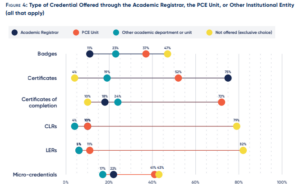Colleges and universities are seeking to expand their horizons by embracing innovative new ways to reach students and generate revenue. Consequently, professional and continuing education (PCE) units are a ripe sector to explore. However, as technology becomes more sophisticated and integrated into an institution’s culture, higher ed leaders seem unprepared to blend these exciting new opportunities with the old guard—the academic registrar.
In the American Association of Collegiate Registrars and Admissions Officers’ (AACRAO) new survey on how institutions are mediating PCE units’ coexistence with the academic registrar, they found that once-siloed PCE units that are now converging with the academic registrar are causing internal tension and confusion.
“Because the two units have been organically grown for years to be separate institutions and to offer different things, it is difficult to grow together without knowing the goals of each or having a relationship,” one anonymized respondent said in the report.
Among the respondent who reported a PCE unit present at their institution, nearly all said it is separate from their academic registrar (93%). Moreover, only 14% of respondents report no barriers to the PCE unit and the academic registrar working closely together. The most common problems among the nearly nine out of 10 who reported barriers blame a lack of common practices (54%), common policies (52%) and shared technologies (46%).
Additionally, managing student record-keeping proves to be a challenge in integrating both entities, especially among institutions that seek to convert PCE units to academic credits. Specifically, only 53% of respondents confirmed their PCE units and the academic registrar shared the same student information system, and 33% shared the same registration system. Nearly a third of all respondents said they have no technologies in common (34%).
Institutions’ academic registrars are still trying to determine their primary relationship with their PCE unit. No predominant relationship type has yet to truly emerge. Only 21% of respondents said their engagement is to formally address mutual strategic initiatives, policies and practices. In fact, only 53% of respondents recognized an existing strategic initiative at their institution with regard to PCE units; 17% indicated none existed, and 30% were not sure. Non-strategic interactions that are operational in nature currently made up the highest response rate at 33%.
These responses largely confirm the work of Modern Campus and UPCEA’s annual State of Education 2023 report in March. In that report, administrative burden and lack of staffing contributed to respondents’ belief that their institution was unprepared to meet its professional, continuing and online (PCO) unit goals.
AACRAO defines a professional and continuing education (PCE) unit as including “a variety of activities throughout the lifelong learning continuum, such as
programs designed for specific constituencies, including adult degree completers and learners seeking professional credentials and enrichment programs.” Respondents in this report selected their answers based on this definition.
The report garnered responses from 319 individuals across 309 institutions; 69% represented the academic registrar unit, 20% represented the PCE unit and 11% represented both units.
This report was created with the University Professional and Continuing Education Association (UPCEA) and funded by Modern Campus.
More from UB: Texas A&M’s botched faculty hiring reaches top of the ladder, claims president’s job








